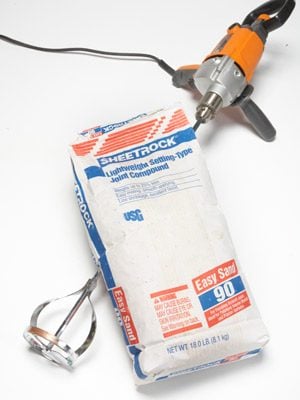Drywall Finishing with Setting-Type Joint Compound
Updated: Dec. 11, 2023
Here's why it's worth it to use setting drywall compound.

When finishing drywall, most DIYers stick with the ready-to-use stuff sold in buckets and shy away from the powdered stuff sold in bags. That’s often a smart choice. “Setting” compound is a hassle: You have to mix it with water, it’s harder to clean up, and you don’t get one of those nifty buckets. Still, setting compound is sometimes worth the trouble.
When to use it
Setting compound is perfect for deep gaps before you tape the joints. It hardens fast, so you don’t have to wait all day before you tape over it. And because it barely shrinks, you don’t have to apply several layers to fill deep voids.
If you use mesh joint tape, use setting compound to embed the tape. Mesh isn’t as strong as paper tape, but the extra strength of setting compound provides a strong joint. There’s no need to use setting compound after the first coat.
What to buy
Buy “lightweight” setting compound. Never, ever buy regular setting compound; it gets rock-hard and is almost impossible to sand.
Setting compounds have brand names that include a number to indicate roughly how many minutes of working time you’ll get before hardening begins. Two examples are Quick Set Lite 5 and Easy Sand 210. For deep filling, 20- or 45-minute compounds are a good choice. For embedding mesh tape, choose 90 minutes or longer.
Mixing and cleanup
You can mix small batches with a putty knife, but for larger amounts, a powerful drill with a mixer is best. Either way, the key to a smooth mix is to let it sit or “slake” for a minute or two after the initial mixing. That gives the chunks time to absorb water. Then mix until the compound is free of chunks.
Clean your tools ASAP. Don’t just toss them in a bucket of water. Unlike standard joint compound—which softens after a good soaking—setting compound continues to harden even under water. Here are some factors to consider when deciding between paper versus mesh drywall tape.
— Gary Wentz, Senior Editor
For more great information about finishing and sanding drywall, check out these articles:
– Tips for Finishing Drywall
– How to Sand Drywall
– How to Repair Holes in Drywall